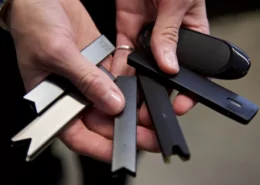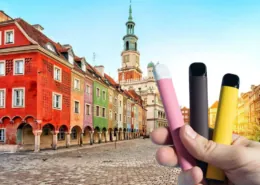Water-Based Vaping: Is It the Future of Vaping?
Water-based vaping technology is the latest innovation in the vaping industry, promising a smoother, cleaner, and more natural vaping experience. With a 30% water content in the e-liquid, Aquios Labs has managed to create vape kits that are capable of handling less viscous liquids, thus leading the way in this new field. In this article, we’ll delve deeper into water-based vaping technology and explore its benefits, downsides, safety, and whether it’s the future of vaping.
Understanding Water-Based Vape Technology
Water-based vaping cannot be achieved simply by adding water to conventional e-liquid. Thus, specific technology had to be developed to make this happen. While a handful of brands have attempted this in the past, Aquios Labs is the only one that has managed to master it. They have developed innovative hardware that can handle less viscous liquids such as water, creating vape kits that contain e-liquid with a 30% water content. This is far higher than the 3% water content found in most e-liquids on the market.
Read More: What is Nicotine Salt
How Water-Based Vaping Works
Essentially, water-based vaping works just like a normal vape. The e-liquid is heated up and turned into a vapor that the user inhales.
Can You Vape Water?
While it’s not advisable to vape just water, many store-bought e-liquids contain a small amount of water content. However, water lacks viscosity, making it more prone to leaking and damaging your device. Some brands are exploring the concept of water-based vaping by developing vape kits that can handle this thinner, watered-down e-liquid.
The Benefits of Water-Based Vaping
Although still in its infancy, there are already some benefits to vaping with a water-based device or e-liquid:
1. Improved Flavor Clarity
Water-based e-liquid can improve a user’s overall vaping experience by enhancing flavour clarity. Conventional e-liquid usually contains vegetable glycerine (VG), which has a slightly sweet taste. Replacing some of this VG content with water can minimize its overall sweetness, ensuring you always experience the full taste of your chosen e-liquid flavour.
2. Reduced Irritation
Reducing the amount of propylene glycol (PG) in e-liquid and replacing it with water can deliver a smoother and more natural vape that minimizes irritation. As water is a natural substance that’s abundant in our bodies, it’s more easily absorbed, reducing the chance of dehydration and leading to a more pleasant vaping experience.
3. Lower Temperatures
Water has a lower boiling point than PG and VG, allowing a water-based vaping device to operate at a lower temperature than a conventional vape kit. This helps to keep your device cool, lowering the chances of overheating and improving chemical stability.
The Disadvantages of Water-Based Vaping
One consequence of using water-based e-liquid is that it produces less vapor. Water replaces some of the VG content responsible for dense vapor production, which won’t be great news for cloud chasers and fans of sub-ohm vaping. Another possible downside of water-based vaping is a lacklustre throat hit, which may not be satisfying for some users.
Is Water-Based Vaping Safe?
The standard e-liquid formulation used in MTL vape devices has been through thousands of tests and hundreds of studies, making it orders of magnitude safer than smoking. Water-based devices also have to go through emissions testing and be submitted to the MHRA. This should mean that water-based vape devices are at least as safe as their standard counterparts. While there are concerns that water-based vape devices could harbor bacteria, research has shown that a 30% PG solution is sufficient to kill a number of strains of bacteria, and ingredients such as nicotine and some flavors can also increase antibacterial properties.
Toxins are already much lower in vapor than in cigarette smoke, and they should be lower again in water-based vaping devices since the heating point is lower than it is for standard e-liquid. However, more research and emissions testing for e-liquids with a 30% water content are needed to confirm their safety fully.
The World’s First Water-Based Vape Kit
Yes! Thanks to Aquios Labs’ technology, they’ve recently released a device that uses their innovative AQ30 30%-water e-liquid. By partnering with hardware brand Innokin, users can get their hands on the world’s very first water-based vape kit — the Lota F600. This disposable vape kit promises to deliver a smoother and more discreet vaping experience when compared to regular disposables, available in a range of popular and exciting flavors.

Read more: 10 Best Disposable Vapes for 2023 in UK
The Verdict
The introduction of water-based technology is an exciting advancement in the world of vaping, promising a smoother, cleaner, and more natural vaping experience. However, water-based vaping isn’t for everyone, especially cloud chasers and fans of sub-ohm vaping who prefer dense vapor production and strong throat hits.
The benefits of water-based vaping include better flavor, less irritation, and lower operating temperatures. Meanwhile, potential downsides include less vapor production and a lack of throat hit. As for safety, water-based devices have to go through emissions testing and are submitted to the MHRA, making them at least as safe as standard counterparts. However, more research and emissions testing for e-liquids with a 30% water content are needed to confirm their safety fully.
In conclusion, while water-based vaping technology is still in its infancy, it has great potential to revolutionize the vaping industry. As vaping trends continue to evolve, water-based vaping is certainly worth keeping an eye on. Whether or not it becomes the future of vaping remains to be seen, but we’re excited to see how it develops in the future.
- Minneapolis Sets $25 Minimum Price for E-Cigarettes - July 11, 2025
- Alabama Schools to Implement New Anti-Vaping Policies - July 11, 2025
- Is Vaping and Driving Illegal in Rhode Island? (2025 Guide) - July 10, 2025









